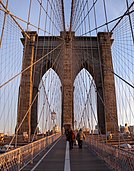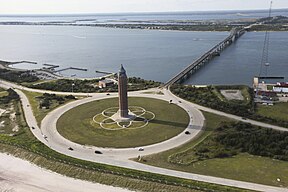
Back Long Island ALS Langīeg in þǣm Nīwan Eoforwīce ANG لونغ آيلند Arabic لونج آيلند ARZ Long Island AST Lonq-Aylend Azerbaijani Long Island BAR Лонг Айлънд Bulgarian লং আইল্যান্ড Bengali/Bangla Long Island (New York) Breton
Native name: Paumanok[1] | |
|---|---|
 Location of Long Island in New York state | |
Location of Long Island in the United States | |
| Geography | |
| Location | Atlantic Ocean |
| Coordinates | 40°48′N 73°18′W / 40.8°N 73.3°W |
| Area | 1,376.1 sq mi (3,564 km2) |
| Highest elevation | 401 ft (122.2 m) |
| Highest point | Jayne's Hill |
| Administration | |
| State | New York |
| Largest settlement | Brooklyn, New York City (pop. 2,736,074) |
| Demographics | |
| Demonym | Long Islander |
| Population | 8,063,232 (2020) |
| Pop. density | 5,859.5/sq mi (2262.37/km2) |
| Ethnic groups | 54.7% White, 20.5% Hispanic or Latino of any race, 20.4% Black, 12.3% Asian, 8.8% other races, 3.2% from two or more races, 0.49% Native American, and 0.05% Pacific Islander |
| Part of a series on |
| Regions of New York |
|---|
 |
| Part of a series on |
| Long Island |
|---|
 |
| Topics |
| Regions |
Long Island is a densely populated continental island in southeastern New York state, extending into the Atlantic Ocean. It constitutes a significant share of the New York metropolitan area in both population and land area. The island extends from New York Harbor 118 miles (190 km) eastward into the ocean with a maximum north–south width of 23 miles (37 km).[2][3] With a land area of 1,401 square miles (3,630 km2), it is the largest island in the contiguous United States.[4]
Long Island is divided among four counties, with Kings (Brooklyn), Queens, and Nassau counties occupying its western third and Suffolk County its eastern two-thirds. Long Island may refer both to the main island and the surrounding outer barrier islands. To its west, Long Island is separated from Manhattan and the Bronx by the East River tidal estuary. North of the island is Long Island Sound, across which lie Westchester County, New York, and the state of Connecticut. Across the Block Island Sound to the northeast is the state of Rhode Island. Block Island, which is part of Rhode Island, and numerous smaller islands extend farther into the Atlantic Ocean. To the extreme southwest, Long Island, at Brooklyn, is separated from Staten Island and the state of New Jersey by Upper New York Bay, The Narrows, and Lower New York Bay.
With a population of 8,063,232 residents as of the 2020 U.S. census, Long Island constitutes 40% of New York state's entire population.[5][6][7][8][9] Long Island is the most populous island in any U.S. state or territory, the third-most populous island in the Americas after Hispaniola and Cuba, and the 18th-most populous island in the world ahead of Ireland, Jamaica, and Hokkaidō. Its population density is 5,859.5 inhabitants per square mile (2,262.4/km2). Long Island is culturally and ethnically diverse, featuring some of the wealthiest and most expensive neighborhoods in the world near the shorelines, as well as working-class areas in all four counties.
As of 2022, Kings, Queens, Nassau, and Suffolk counties collectively had a gross domestic product of approximately $500 billion.[10] Median household income on the island significantly exceeds $100,000, and the median home price is approximately $600,000, with Nassau County approximating $700,000. Among residents over the age of 25, 42.6% hold a college degree or higher educational degree.[11] Unemployment on Long Island stays consistently below 4%. Biotechnology companies, engineering, and scientific research play a significant role in Long Island's economy,[12] including research facilities at Brookhaven National Laboratory, Cold Spring Harbor Laboratory, Stony Brook University, New York Institute of Technology, Plum Island Animal Disease Center, the New York University Tandon School of Engineering, the Zucker School of Medicine, and the Feinstein Institutes for Medical Research.
As a hub of commercial aviation, Long Island is home to two of the nation's and New York metropolitan area's busiest airports, JFK International Airport and LaGuardia Airport.[a] Also located on Long Island are Long Island MacArthur Airport and two major air traffic control radar facilities, New York TRACON and New York ARTCC. Long Island has nine major bridges and thirteen navigable tunnels, which connect Brooklyn and Queens to the three other boroughs of New York City. Ferries connect Suffolk County northward across Long Island Sound to Connecticut. Long Island Rail Road is the busiest commuter railroad in North America and operates continuously.[13]
- ^ Richmond Hill Historic Society Archived May 15, 2013, at the Wayback Machine Tributary tribes
- ^ "Long Island Facts". LongIsland.com. Archived from the original on March 5, 2023. Retrieved October 23, 2022.
- ^ "Long Island". Encyclopædia Britannica (Britannica Concise ed.). Encyclopædia Britannica, Inc. 2011. 9370515. Archived from the original on November 5, 2007. Retrieved April 30, 2011.
- ^ John Burbidge (November 21, 2004). "Long Island at its Best; Who's the Longest of Them All?". The New York Times. Archived from the original on April 30, 2011. Retrieved April 30, 2011.
But the court wasn't saying Long Island isn't an island in a geographical sense", he continued. "In fact, all parties involved in the case agreed Long Island is a geographical island. It was only for the purposes of the case that the island was declared an extension of New York's coastline.
- ^ "Annual Estimates of the Resident Population: April 1, 2010 to July 1, 2015 - 2015 Population Estimates". United States Census Bureau. Archived from the original on May 15, 2016. Retrieved March 24, 2016.
- ^ "Kings County, New York QuickFacts". U.S. Census Bureau. Archived from the original on February 17, 2016. Retrieved March 24, 2016.
- ^ "Queens County, New York QuickFacts". U.S. Census Bureau. Archived from the original on August 8, 2014. Retrieved March 24, 2016.
- ^ "Nassau County, New York QuickFacts". U.S. Census Bureau. Archived from the original on June 7, 2011. Retrieved March 24, 2016.
- ^ "Suffolk County, New York QuickFacts". U.S. Census Bureau. Archived from the original on June 24, 2011. Retrieved March 24, 2016.
- ^ "Gross Domestic Product by County and Metropolitan Area", fred.stlouisfed.org, archived from the original on January 4, 2024, retrieved January 13, 2024
- ^ "Long Island" Archived August 13, 2022, at the Wayback Machine at New York Fed
- ^ [1] Archived November 16, 2016, at the Wayback Machine Accessed November 16, 2016.
- ^ "Transit Ridership Report Fourth Quarter and End-of-Year 2014" (PDF). American Public Transportation Association (APTA). March 3, 2015. Archived from the original (PDF) on October 11, 2017. Retrieved October 28, 2016.
Cite error: There are <ref group=lower-alpha> tags or {{efn}} templates on this page, but the references will not show without a {{reflist|group=lower-alpha}} template or {{notelist}} template (see the help page).











